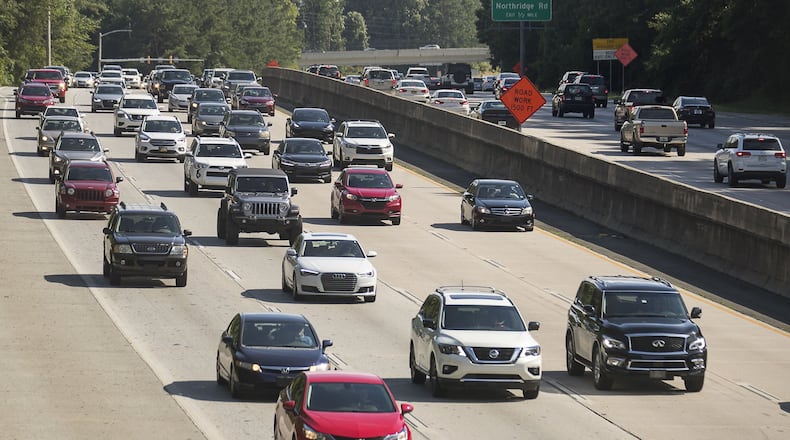Expansion of Ga. 400 — the most transformative road project for north Fulton County in decades — is several years away, but nearby cities have only a short time to push changes that will affect the commute of thousands in the northern suburbs.
The addition of tolled express lanes and bus rapid transit stations on Ga. 400 has spurred the cities of Roswell, Sandy Springs and Alpharetta to intervene to protect neighborhoods bordering the busy highway.
The mayors of all three cities told The Atlanta Journal-Constitution that traffic complaints are what they hear most from voters. But without being in charge of highway design — especially the interchanges leading to the highway — cities fear they will lose any opportunity to ensure their communities are not unexpectedly saddled with extra traffic or noise caused by poor design.
“You can’t sell a house with Spaghetti Junction in your yard,” said Kayla Engle-Lewis, who lives with her husband a few hundred feet from where the flyover lanes would be.
Though the Georgia Department of Transportation (GDOT) has fought against that characterization, Engle-Lewis said the lanes would be a noise issue because so many trees were taken down in the recent rebuild of Northridge Road, which the flyover lanes would go over.
READ | Fulton adds rapid buses on I-285 to transit plan, vote in 2020 likely
It is crunch time for negotiations between GDOT and the cities, all of whom are at different stages drawing up changes in roadway plans. The cities and GDOT have to figure out who is picking up the tab for which elements and if those plans align with what the cities have planned for themselves in the future.
Everyone agrees that this level of back-and-forth for such a massive road project is rare, but that’s because the ripples will be felt for decades. But GDOT can’t wait much longer if it’s going to keep the $1.6 billion project on schedule.
“At some point, we have to put our pencils down,” said Tim Matthews, who is managing the project for GDOT.
‘Once-in-a-lifetime opportunity’
It makes sense the state would want to confer with these three cities before messing with their commutes. Roswell, Sandy Springs and Alpharetta wield some serious power in the form of voters and money.
Together they hold about a quarter of Fulton County's population, and all three are all well above the county median household income — U.S. Census data from 2017 shows that Alpharetta's is $98,489 compared to the Fulton median of $61,336.
When asked why there is more negotiation than normal with these cities, Matthews with GDOT said: “Because it is a bigger effort, we’re doing way more than we’re required to do.”
Credit: ALYSSA POINTER / ALYSSA.POINTER@AJC.COM
Credit: ALYSSA POINTER / ALYSSA.POINTER@AJC.COM
The cities hope to hold onto what makes them unique even as GDOT builds 16 miles of new express lanes and four bus rapid transit stations — MARTA’s first step toward expanding service — between the North Springs MARTA station and McFarland Parkway in Forsyth County.
“For GDOT, it’s just building a bridge. For us, as many cars as we have on 400, it’s an entrance to our city that’s very important,” said Roswell Mayor Lori Henry.
According to GDOT, the road handles about 220,000 vehicles (round-trips get counted twice) a day.
Roswell City Council tasked its staff Wednesday with finding a way to spend under a couple million of dollars to give two bridges over Ga. 400 the same look. It’s either that or have standard gray highway bridges at city gateways for the next half-century.
Roswell councilwoman Marie Willsey at a June meeting went further. “I just think this is a great opportunity to kind of unify and welcome, and give us a real distinctive (look) … it’s a once-in-a-lifetime opportunity.”
Though the other two cities are not as far along as Roswell, the state is dealing with wishlist items like Sandy Springs wanting to get rid of planned flyover overpass lanes. Alpharetta also wants changes, but first they want more data on local traffic impacts.
Sandy Springs Mayor Rusty Paul said he doesn’t want his city on the losing end of the “three-dimensional chess” that GDOT is playing.
“They’ve done a masterful job,” Paul said. “Doesn’t mean it doesn’t have serious disruptions.”
READ | Ga. 400 expansion encroaches on Sandy Springs neighborhoods
Paul wrote a letter in mid-June to GDOT Commissioner Russell McMurry suggesting changes, including nixing flyover lanes at Northridge Road and running them under the bridge there.
“You got these huge concrete structures sticking into space … it destroys the gateway to the city,” he said. But Paul said there’s some conflict with Fulton County Schools standards if the lanes were moved.
“This is a mammoth jigsaw puzzle they’re putting together in the area,” Paul told the AJC before acknowledging why GDOT would push back. “We’re playing with the most critical parts of the puzzle.”
Fulton County Schools Superintendent Mike Looney said in a statement to the AJC that his district will “uncompromisingly work to ensure the safety of our students and staff while maintaining good stewardship of the taxpayers’ money … We are still in the process of assessing the potential impact these options may have on our schools along the corridor.”
All the stakeholders wanting one thing or another means GDOT is getting noise from all sides.
“It’s not like we’re ignoring anyone or asking them for permission,” said Matthews with GDOT said of those along the corridor. “We’re getting as much information as we can for our process with state and federal (regulations).”
‘Pain we intend to endure’
This project’s impact stretches beyond the 16 miles of express lanes being added to a congested stretch of road, but it represents the future of transportation in metro Atlanta.
However, city council members who serve for a few years don’t usually get credit for projects that improve metro traffic decades from now.
“In the meantime we’re going to receive the big drain for all the folks who are coming out of Forsyth who want to get on the BRT; they’ll come and park in Alpharetta,” said Alpharetta Mayor Pro-Tem Donald Mitchell during a June meeting.
Alpharetta Mayor Jim Gilvin said he was disappointed with GDOT and MARTA for the lack of data during their presentations during the meeting.
“I understand we’re a region, and we’re critical to what happens transportation-wise in the region, but there’s only so much pain we intend to endure for Gwinnett, Cherokee, Forsyth counties and, quite frankly, some of our neighbors in North Fulton,” Gilvin said.
Gilvin just wants to know if all this will be worth it.
“I think I understand why you want to do it because it’s the first spine of an extensive transit project 30, 60 years down the road when Cherokee and Forsyth are dying of congestion and they finally submit to being part of MARTA, but that doesn’t help us for the next 10 or 20 or 30 years,” Gilvin said in a meeting.
Matthew told the AJC that once September is over, they have to move forward with sending a plan to Federal Highway Administration for environmental approval and then putting it out for bid.
“We can’t keep changing things for them to react (to),” he said.
Like North Fulton County News Now on Facebook | Follow on Twitter
About the Author
The Latest
Featured







